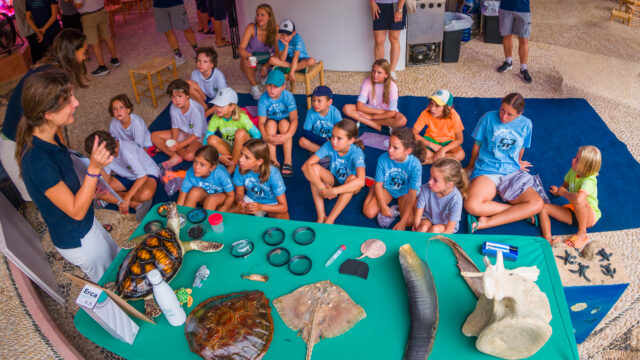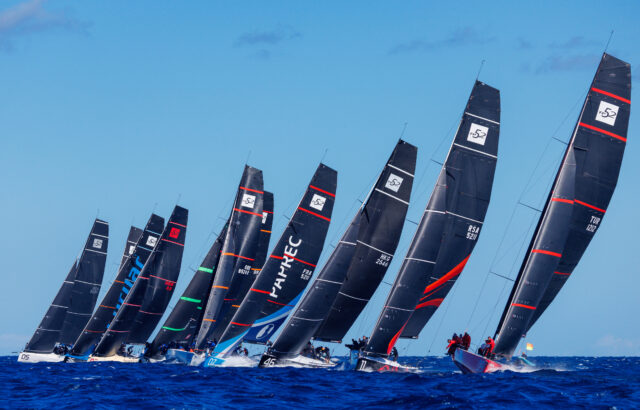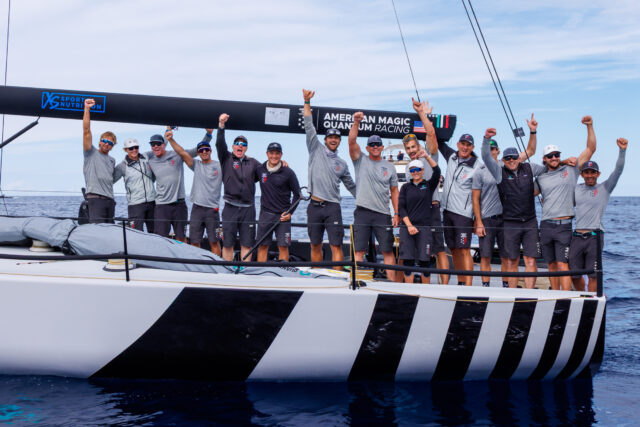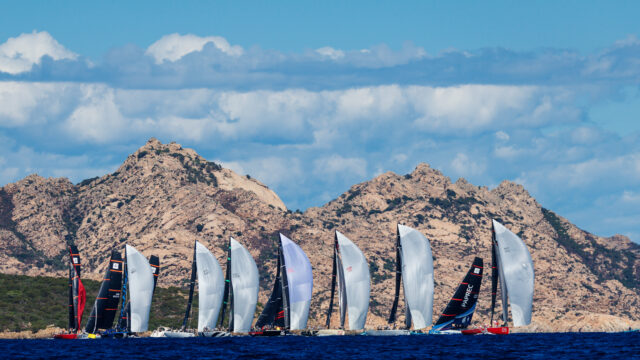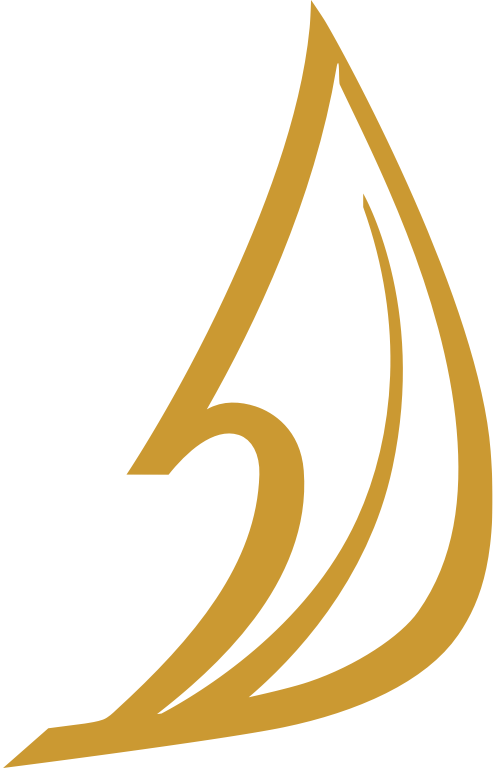Botin Partners hold an enviable record in the TP52 class, designers of the boats which have won the 52 SUPER SERIES or the MedCup every year since 2008 with Quantum Racing(s), Emirates Team New Zealand and Azzurra. They have had a busy autumn and winter designing the class’s latest entrant, the new Brazilian flagged Phoenix which will debut at Palma Vela in April, before taking on the 52 SUPER SERIES in Europe.
Partner Adolfo Carrau brings us up to speed on developments for the newest 52:
What are the differences, will they be noticeable?
For the guys on the circuit who know boats closely they will see some differences on the hull shape and more obviously on the deck layout with the new 2015 rule. Cockpit volume is not enforced anymore and we can be a bit more creative about winch placement and so on.
I think we spent an awful lot of time with the structural engineers to find what is optimum because it really is very tempting to empty the cockpit completely. It has some structural disadvantages so we looked for the best trade offs. And we looked of course to just keep the boat as light as possible within the rules and as stiff as possible. But all in all we have made another big jump, a nice jump compared to previous boats compared to where we were. Amazingly after several generations we still make the boats faster and stiffer and also to comply with the ISO and GL scantlings. So a lot of refinement went into the deck and the structural layout.
The other area of interest is the keel, it needs to be 200 kilos lighter. We did spend a lot of time working not just on the hydrodynamic shape but also the structure to see how we could make a keel which is lighter but we did not want to make it any smaller. And so now the keels are steel and composite so that was a big job. Another area of benefit is in the new mast, the high modulus carbon, the deflector and the composite rigging, that is a good decision by the class. The deflector especially is good but that in itself did create some issues for the internal structure as there is already a lot of rope running below and to run a system below decks has been a bit of a challenge, which we have just overcome recently.
So the boat is now 99 per cent designed and engineered there are just some very small pieces missing and the yard is full on. They are on target. It has been a very interesting four months working on this with the new rule. The boats are 300 kilos lighter and so next year the boat will be ballasted compared to the 2011 rule which is the one we used for Quantum Racing and Azzurra, the boat is 300kgs lighter and so the hull shape is going to be different. The hull shape is different in the sense that fleet has changed. Our boats have always been specially good upwind, we make good upwind TP52 boats and with this boat we really tried to improve it downwind, although they were never slow downwind they were specially good upwind. So we tried not to lose anything upwind but to make the boats slightly quicker downwind. That was the focus of our research here, I think we have achieved that but we will see on the water in a few months. But Marcelino, myself and the rest of the team put a lot of effort in to see where we could make some gains. We found some interesting new shapes to improve the downwind without compromising the upwind speed. To the trained eyes, well they will very quickly notice the difference, but to someone else they might all look similar, but they are all different. The stern is different, the bow is different and the midships sections are different, so, it is all different! You would definitely recognise a Botin hull, the bow and stern are treated differently and are different. It will have the same genes, the same pedigree but to the new rule.
Even for us it is interesting that we are managing to keep on developing new ideas even after so many years in the class.
How important is the data you have collected over the years and how does your relationships with the teams work?
We work so closely with the teams, not only Azzurra and Quantum Racing but all the (Botin) teams. It is a very straightforward relationship with all the teams, since the Emirates
Team New Zealand days and the Quantum Racing days when we were first and second, after each day of racing we receive a report from the teams how they did. We try to comment and say what we think they can do to improve as much as we can. Of course these teams are so good they need very little help, but the newer teams we try to help as much as possible, how to set the boats up and how to sail them upwind and downwind. We knew where to head with this new hull and so obviously both Quantum and Azzurra are going to be looking at this new hull with special interest, during the year and seeing what they would like to change with the hull, deck, systems. I am sure most of the teams will be looking very closely at this boat.
Where does the TP52 feature in terms of importance within your company?
The 52 and the 52 SUPER SERIES and this boat are very important to us, they have been the core business of our office for many years. Although it is a new team it is a very good team. The owner himself is very good and has been sailing for many years at a very competitive level. Although it is very hard to beat the top three teams, Azzurra, Quantum Racing and Rán, we would like this boat to be up there. It will take them a couple of events to find their feet but ideally this should be the fastest boat the in the fleet. That is what we are aiming at and it should be noticeable that the boat is a bit quicker than the other generations. We put all our resources into this boat. This boat had probably more than 10 designers working on it, or more. You would think that after so many boats before it would be an easy process for us, but it is very challenging because of the new rule and we had new ideas and wanted to try new things in every area, for example the bowsprit is longer, and it is going to weigh a bit more and all the weight forward where you don’t want it. And so we have spent a month on a bowsprit! That is what we invest in each 52. All the companionway is new, the pit area is new, we are lucky we work with good project managers, in this case with Micky Costa who did the job with Azzurra and with King Marine, and so each decision Micky speaks to the team and then it goes through the yard, or through Southern Spars or North Sails or whoever it needs to be. It is a Southern rig with sails by North Argentina, a Juan Garay inventory. It is very similar to the people behind Azzurra and they are really helping the Phoenix team as they are good friends, and they know each other for many years. They sailed on the Sotos together and they will develop and two boat test together, the sails and the rig and everything. That is the way this boat is being treated, in many respects it is a continuation of the work we have done with Azzurra.
Is the appendage package, the foils, the same for the owner driver as for the pro driver or is there much of a difference?
We are lucky in having Marcus Blackmore and Jim Swartz buying boats as we get very good feedback from these owners who are amateur drivers. It is different but they very quickly learn how to use the foils to best effect. That is a decision we had to make for the Phoenix. We make the foils as fast and low drag as possible, the owners quickly pick up how the foils work and the reality is that since Quantum Racing in 2008 we do have big foils on our boats compared to our competitors, even given the professional drivers like Terry Hutchinson, Ed Baird, Dean Barker of Guillermo Parada they are ready to give up a little straight line speed for some extra grip on low speed manoeuvres like in pre-start and coming out of the tacks. In reality our foils have been quite forgiving and that is the way the owner drivers feel comfortable. Although there is a little difference between what we would give to an owner driver and the professionals, it is very small. That is part of the success of our formula, not just the new hull but a nice appendage package. It makes the boat relatively easy to set up and sail.
The 64m dollar question, how much quicker?
Every generation is quicker, at least two boat lengths to the windward mark is a nice gain from one generation to the next. That is a dream for a professional team. For an owner-driver maybe that is not enough! But after several generations there are no miracles, but that for us is a real achievement. That is enough to make the cross and extend. That is what we are up to each year.
We have between 10 and 20 designers working on our different projects. Depending on the CFD involved we can have between two and five engineers, and the same with the structures. That depends on the project. On the Beau Geste 80 footer we had six structural engineers from PURE, on the new TP52 between three and four, at least two structural guys full time, and then Marcelino and I and Paolo Periotto and then we have a flexible group of designers.
What is your outlook on the future of the class?
We have had a lot of enquiries through the year. There are several owners looking at how the events will go in 2014, but we are definitely optimistic about the 2015 circuit. Next year there will be Phoenix and the existing teams but for 2015 I hope we will see at least two or three more new owners. Agustin Zulueta, Rob Weiland and Lars Bocking and the whole team on the 52 SUPER SERIES are doing a great job in the management side and the current owners are keeping the circuit stable, so new The 52 has a great resale value and do well in IRC in ORC and they are good offshore boats so the Class has got the right formula for all sorts of events. The designs evolve and remain current and are a good investment. Owners can go to four or five in the Med but have a good boat to do offshore races too. The formula is right and people are doing their homework now and that usually means more owners coming into the circuit.


 52 SUPER SERIES – 2026 SEASON
52 SUPER SERIES – 2026 SEASON
